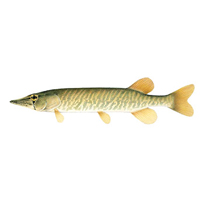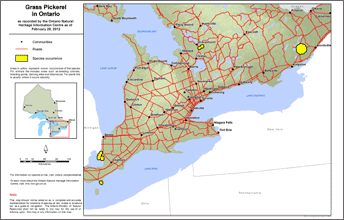Grass pickerel
Scientific name: Esox americanus vermiculatus

Cover photo credit: Joseph R. Tomelleri
Status
Special Concern
“Special Concern” means the species lives in the wild in Ontario, is not endangered or threatened, but may become threatened or endangered due to a combination of biological characteristics and identified threats.
Date added to the Species at Risk in Ontario List
The Grass Pickerel was already assessed as a species of special concern when the Endangered Species Act took effect in 2008.
What it looks like
Like other members of the pike family, the Grass Pickerel has a long, cylindrical body with a long snout and forked tail. The dorsal and anal fins are located well back on the body, enabling sudden high-speed bursts which it uses to help capture prey.
The colour of the Grass Pickerel may vary, but often consists of pale to dark green sides and upper surface with several thin, dark, wavy vertical bars along the sides. The fins are dusky to yellow-green. Adults have a dark bar extending below the eye.
In Ontario, the adult Grass Pickerel is usually less than 30 centimetres long, which distinguishes it from the much larger adults of its near relatives (i.e., Northern Pike and Muskellunge). Juveniles, however, are frequently misidentified because they are less distinctive in appearance and can be the same size as the juveniles of other species.
Grass Pickerel reach sexual maturity at two to three years of age and spawn in the spring (late March to early May). A second period of spawning may take place from late summer into winter.
Where it lives
Grass Pickerel are found in wetlands, ponds, slow-moving streams and shallow bays of larger lakes with warm, shallow, clear water and an abundance of aquatic plants.
Where it’s been found in Ontario
The Grass Pickerel range extends from Minnesota and Nebraska east to southwestern Quebec and south from Ontario and Quebec to Louisiana, Mississippi and Texas. In Canada, it is limited to extreme southwestern Quebec and southern Ontario. In Ontario, Grass Pickerel is found in coastal wetlands in the Great Lakes and tributaries of Lake St. Clair, Lake Erie, Lake Huron, the Niagara River, Lake Ontario and the St. Lawrence River, and inland in the Severn River system.
View a Larger version of this map (PDF)
What threatens it
Grass Pickerel are threatened by activities that may result in decreased water levels, loss of aquatic vegetation, and decreased water clarity. Specific activities that threaten the species include realignment or alteration of agricultural drains, nutrient enrichment through wide-spread application of fertilizers, manure spills and sewage treatment outputs, shoreline modifications and alteration of natural flow regimes.
Action we are taking
Special concern species do not receive species or habitat protection.
What you can do
Report a sighting
- Report a sighting of an endangered animal or plant to the Natural Heritage Information Centre. Photographs with specific locations or mapping coordinates are always helpful.
Volunteer
- Volunteer with your local nature club or provincial park to participate in surveys or stewardship work focused on species at risk.
Be a good steward
- Private land owners have a very important role to play in species recovery. You may be eligible for stewardship programs that support the protection and recovery of species at risk and their habitats.
- Land owners can help improve fish habitat and keep Ontario’s water safe and clean by maintaining natural vegetation next to creeks and rivers, and keeping pollution and soil from washing into Ontario’s rivers. You can find more information about programs and funding assistance for eligible farmers from the Ontario Soil and Crop Improvement Association website at www.ontariosoilcrop.org/en/programs/species_at_risk.htm.
Report illegal activity
- Report any illegal activity related to plants and wildlife to
1-877-TIP-SMNR (847-7667) .
Quick facts
- Often the term ‘pickerel’ is used to refer to walleye (a member of the perch family). In actuality, a ‘pickerel’ is really a member of the pike family..
- The Grass Pickerel is a top predator and hunts by sight, either stalking or ambushing its preferred prey. Young Grass Pickerel usually feed on insects, while adults target other fish, sometimes even eating the young of their own species.
- The Grass Pickerel is widely recognized as a subspecies of the Redfin Pickerel, however recent research suggests that it may be a distinct species.
